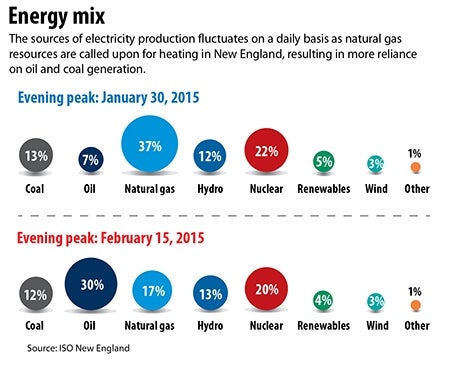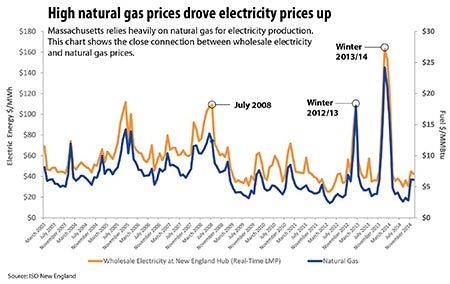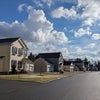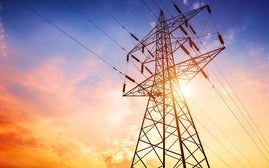Riding the natural gas roller coaster
Natural gas customers throughout New England got an early holiday present as National Grid and Eversource announced that while gas prices will seasonally increase this winter, they will be down compared with last year.
However, even though the majority of electricity generation in Massachusetts is from natural gas, electricity customers will not see the full effect of this year-over-year decline. In fact, that reliance on natural gas for electricity generation is one of the main reasons for the state's volatile electricity prices that rise in the winter.In September, both National Grid and Eversource announced their gas prices for the next six months as they had submitted them to the Department of Public Utilities. Eversource has submitted gas prices that will be 31 percent less than last year's price, at 51.71 cents per therm, down from last November's rate of 74.43 cents. For the average residential customer, this could mean $30 less a month than last winter, according to the company.
For National Grid, the price is also down — although not as sharply — from 67 cents per therm last year to 52 or 53 cents depending on region, with the average residential customer expected to save between $5 and $7 a month compared to last winter.
These prices are down largely due to lower natural gas commodity prices, increased liquid natural gas in the area and more natural gas storage, Eversource spokesman Mike Durand said.
Gas customers aren't the only ones who can expect savings this season. Home heating oil prices are also expected to be low this winter. With a barrel of oil trading at just over $42 and expected to remain low, this will be a good season for oil heat, said Michael Ferrante, president of the Massachusetts Energy Marketers Association, which represents oil distributors.
“Crude oil prices have been really low, and consumers are feeling that on refined products, and those products are everything from gasoline to oil to heating oil,” Ferrante said. The Sept. 30 heating oil price of $2.38 is $1.22 less than the price was a year earlier.
Electricity rates are rising in the region, however, and unlike natural gas and oil, it will not have a large drop from last year.
The National Grid rate of 13.1 cents per kilowatt hour for electricity — which is calculated based on rates secured from generators — over the course of the next six months is a 21-percent increase compared with the current rate.
While this represents a 9-percent decrease compared to prices last winter, those prices were a staggering 37-percent increase over the previous year, meaning electricity prices will still be relatively high this winter.
A large portion of electricity cost — and the reason it jumps in the winter — comes back to natural gas. In the last 10 years, electricity production from natural gas has grown from 15 percent to 44 percent, according to Marcia Blomberg, spokeswoman for regional power grid administrator ISO New England that manages the region's energy transmission.
“The region is very reliant on natural gas for power production. At the same time, with the dropping price for natural gas, the demand has increased for heating,” Blomberg said. “During very cold weather, the pipelines are running full or almost full, and the gas is going to heating customers.”
When the pipelines have no gas left for the power plants, they then buy their fuel from the more expensive spot markets, Blomberg said. At the same time, higher cost generation plants fire up using oil and coal, and the result is higher electricity prices.
The Constrained
This increased demand for natural gas is compounded by constrained pipelines of natural gas into Massachusetts. While the solution to increased energy costs is multifaceted, with alternative energy and efficiency programs being an integral part, in the immediate term there is simply too little natural gas coming into the area to handle the winter electricity load.
“There is still and will continue to be a capacity shortage even though the prices for our gas customers has come down,” National Grid spokeswoman Mary-Leah Assad said. “The capacity restrictions to electricity providers is still there.”
The Answer
To relieve pipeline constraints, the natural gas transmission companies want to expand or add new lines, including the Kinder Morgan pipeline and Access Northeast Project, which has received funding from Eversource and National Grid.
Access Northeast would route a pipeline through Rhode Island and Connecticut into Massachusetts. The project is projected to save $1 billion every winter by allowing more power plants to run on natural gas, said Durand.
“It's to stabilize electrical supply prices… but also on the gas heating and cooking side,” Assad said. “We need additional natural gas to serve the additional demand.”
This will also stabilize energy in the region when combined with other energy sources, such as liquid natural gas and transmission of alternative energy, Blomberg said. “ISO is concerned about it from a reliability perspective. We administer the markets, so we don't project prices. Our number one responsibility is keeping the lights on in New England,” she said. n
















0 Comments